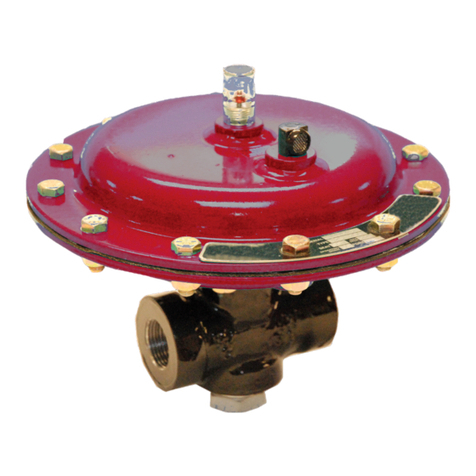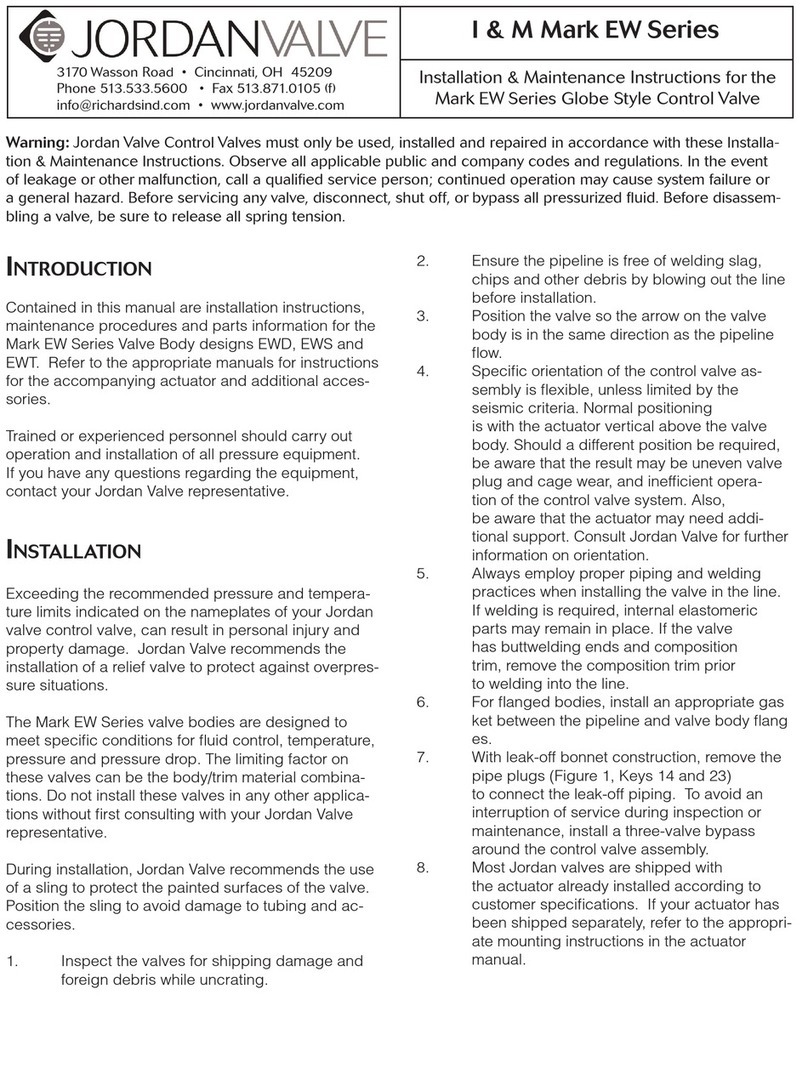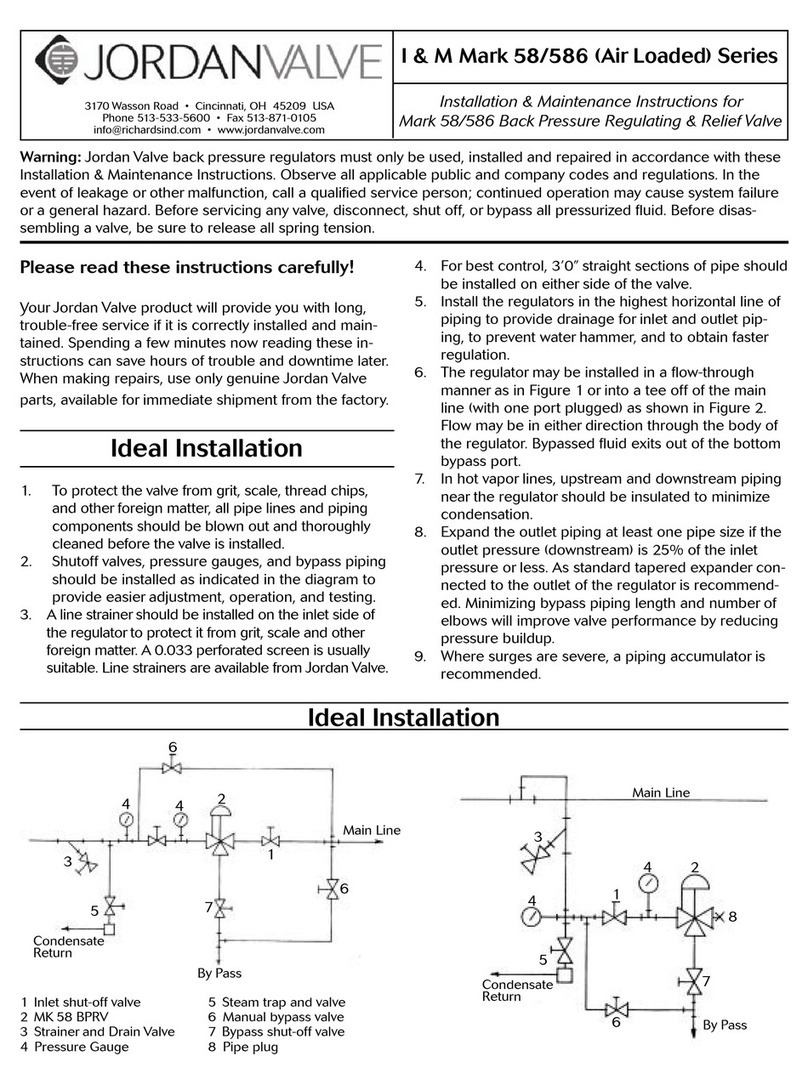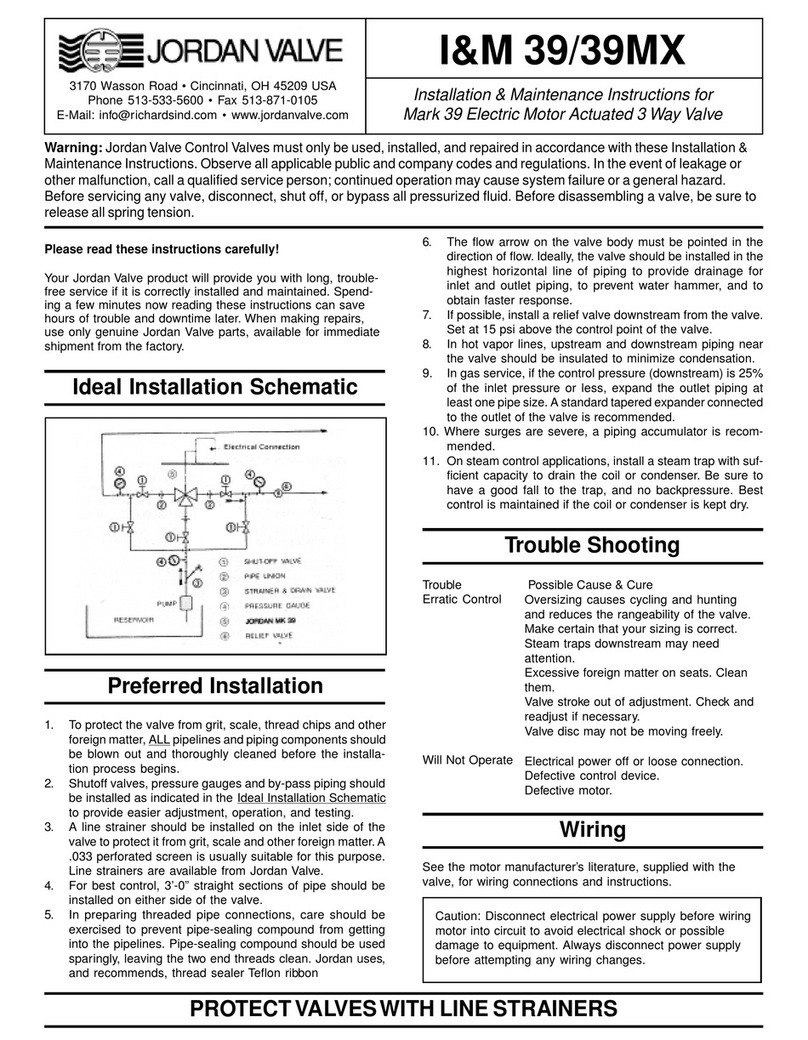
-3-
in until a fine continuous ring of contact has been
made on both surfaces. DO NOT lap until a ridge is
formed in valve plug seating face. A few turns are suf-
ficient. When lapping, turn valve plug in short arcs
and occasionally lift valve plug off seat ring and turn
in 1/4 turn to maintain even distribution of lapping
compound. When lapping is completed, disassemble
bonnet from body and remove all traces of lapping
compound.
Valve Reassembly
1. Place seat o-ring (30) on seat (3) [use small amount
of grease to hold these parts together] and place in
valve body (1). Place seal (42)(soft seated valves) and
support washer (42)(1/2” & 3/8” only) into groove in
seat (3). Place the soft seat (41) and support washer
(42) (if valve is so equipped) into the groove in seat
ring (3). Place cage (2) and compressor (5) into body.
2. Assemble stem/plug (9) to bonnet (4).
3. Reassemble the o-ring (29) and bonnet (4) to the
valve body (1) making sure that seat o-ring (30), com-
pressor (5), cage (2), seat (3), seal (41), and support
washer (42) are properly in place.
4. Install a new set of packing (13) and related parts as
described in “Packing Replacement”.
5. Insert the stem/plug (9) through the bottom of the
bonnet (4). Reassemble two stem nuts (28), travel in-
dicator (12) and indicator washer (12) to valve stem
(9).
6. Insert threaded end of bonnet (4) through hole in
yoke (33) and secure actuator to the body with the
Lock Ring (32). Tighten Securely.
7. Lift the valve stem (9) and thread it into the stem
connector (17) at least one diameter. Adjust actuator
spring preload as described in the following section.
Actuator Spring Preload Adjustment
(Starting Pressure)
Caution: Do not apply more than 45 psig to actuator.
Direct Acting Actuator (ATC): Actuator spring pre-
load adjustment can be made either with or without
pressure in valve body. Once correct compression is
made, no further adjustment is necessary.
Reverse Acting Actuator (ATO): Note: ATO 3-15
psig rated valves are bench set at the factory at 5-17
psig. Please insure that any I/P utilized with this con-
trol valve is capable of 17 psig output to ensure full
valve travel. If desired, the range may be changed to
suit your needs by following the instructions below.
The valve plug is closed against upward fluid thrust
by actuator spring force. Total compression placed on
actuator spring must be sufficient to provide the re-
load plug force required to close the valve. If preload
adjustment is made with no pressure in valve body,
then, when the control valve is placed in operation,
body, then, when the control valve is placed in opera-
tion, additional compression must be placed on the
spring to provide valve closure force. With proper ad-
justment, valve will close tightly and will not begin to
open until the preload pressure is exceeded.
Adjusting Spring Preload:
1. Loosen two stem nuts (28), move them along with the
travel indicator (12) down the stem (9) and lock two
stem nuts together.
2. Connect control air supply line with a pressure gauge
to the diaphragm case (16 for ATO or 26 for ATC).
3. Direct Acting Actuator (ATC 3-15 Range):
Note: If range is other than 3-15, adjust preload to low
end of range.
Adjust spring preload until valve starts to close when
3 psig air pressure is supplied to the actuator dia-
phragm. If there is valve movement at less than 3
psig: thread the valve stem (9) into the actuator stem
(17), wrenching on locked stem nuts (28) and on the
flats of the actuator stem (17) to increase the spring
preload. If there is no movement at 3 psig: thread
the valve stem (9) out of the stem connector (17) to
decrease the spring preload.
4. Reverse Acting Actuator (ATO 3-15 Range): Jordan
control valves rated 3-15 (ATO) are bench set at the
factory at 5-17 psig. Please insure that any I/P utilized
with this control valve is capable of 17 psig output to
ensure full valve travel. If desired, the range may be
changed to suit your needs by following the instruc-
tions. In general, adjust 3-15 range to 5 psig; all other
ranges are adjusted to the low end of the range.
Adjust spring preload until valve just starts to open
when 5 psig air pressure is supplied to the actuator
diaphragm. If there is valve movement at less than
5 psig: thread the valve stem (9) out of the actuator
stem (17), wrenching on locked stem nuts (28) and
flats on actuator stem (17) to increase the spring pre-
load. If there is no valve movement at 5 psig: thread
the valve stem (9) into the actuator stem (17), wrench-
ing on locked stem nuts (28) and flats on actuator
stem (17) to decrease the spring preload.
Note: alternately adjust preload and check pressure
to start valve movement by raising pressure to 5 psig
(or pressure required to start movement) until proper
adjustment is attained.
5. After proper spring preload has been attained, loosen
two stem nuts (28), thread them along with the indi-
cator washer (12) up the stem (9) and lock against
the end of the actuator stem (17). If necessary, adjust
the position of the travel indicator (35) by loosening



























